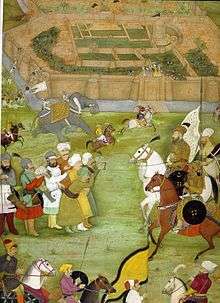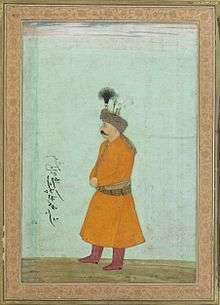Mughal–Persian Wars
The Mughal–Persian Wars were a series of wars fought in the 17th and 18th centuries between the Safavid and Afsharid Empires of Persia, and the Mughal Empire, over what is now Afghanistan. The Mughals consolidated their control of what is today India and Pakistan in the 16th century, and gradually came into conflict with the powerful Safavids and Afsharids, led by Abbas I and Nader Shah respectively. Aside from Nader Shah's invasion of the Mughal Empire, most of the conflict between the two powers were limited to battles for control over Kandahar.[4]
| Mughal–Persian Wars | |||||||
|---|---|---|---|---|---|---|---|
 Representation of Nader Shah at the sack of Delhi | |||||||
| |||||||
| Belligerents | |||||||
|
| |||||||
| Commanders and leaders | |||||||
|
Abbas I of Persia Abbas II of Persia Mehrā Khan Autar Khan Nader Shah Heraclius II of Georgia |
Jahangir Kilij Khan Murad Baksh Dara Shikoh Aurangzeb Muhammad Shah | ||||||
| Strength | |||||||
|
Appx. 50,000 in 1623 62,000 in 1649 55,000 in 1739[1][2][3] |
3000 in 1623 98,000 in 1638 2000 in 1649 | ||||||
| Casualties and losses | |||||||
| ~7500 | ~27,000 | ||||||
War of 1622–23
The Mughal–Safavid War of 1622–23 was fought over the important fortress city of Kandahar, in Afghanistan, between the Safavid empire of Persia and the Mughal empire of India. It resulted in a clear Persian victory.
Having secured crushing victories against the Ottomans, Shah Abbas desired to capture the strategic fortress on Kandahar since he had lost it in 1595.[5] In 1605 the governor of Herat, Hosayn Khan, besieged the city but the tenacious defense of the Mughal governor, Shah Beg Khan, and the arrival in the next year of a relieving Mughal army to Kandahar forced the Safavids to retreat.[6][7] With the conclusion of the Ottoman-Safavid War (1603-1618), Shah Abbas was secure enough for a war on his eastern frontier,[5] so in 1621 he ordered an army to gather at Nishapur.[5] After celebrating the new year at Tabas Gilaki in southern Khorasan, Abbas joined with his army and marched on Kandahar where he arrived on 20 May and immediately began the siege.[5] Though Jahangir had information of the Persian's movements he was too slow to respond,[5] and without reinforcements the small garrison of 3,000 men could not hold for long against the superior Persian army.[8]
The Emperor asked his son and heir apparent Khurram who was at Mandu in the Deccan to lead the campaign, but Khurram evaded the assignment fearing to lose his political power while he was away from court.[9] The relief force the Mughals could assemble proved too small to raise the siege,[7] so after a 45-day siege the city fell on 22 June followed shortly after by Zamindawar.[10] After fortifying the city and appointing Ganj Ali Khan as governor of the city,[6] Abbas returned to Khorasan via Ghur, subduing on the way troubling emirs in Chaghcharan and Gharjistan.[11] The rebellion of Khurram absorbed the Mughal's attention, so in the spring of 1623 a Mughal envoy arrived at the Shah's camp with a letter from the Emperor accepting the loss of Kandahar and putting an end to the conflict.[12]
War of 1638

In spring of year 1638, the Mughal Emperor Shah Jahan himself led the massive Mughal army of around 100,000 troops to reconquer the province of Kandahar. Accompanied by his sons, the city was completely blockaded as the emperor had targeted a greater campaign for conquering not only the Persian frontiers, but also the conquest of central Asia. Within a month, the Safavid governor surrendered to the Mughal forces and Kandahar was once again became a part of the vast Mughal Empire.[13] Kandahar in particular was at the crossroads of a number of major commercial trade routes in Central Asia. The two cities were thus the subject of deep strategic concern.[14]
War of 1649–53
The Mughal–Safavid War of 1649-53 was fought between the Mughal and Safavid empires in the territory of modern Afghanistan. The war began after a Persian army, while the Mughals were at war with the Janid Uzbeks, captured the fortress city of Kandahar and other strategic cities that controlled the region. The Mughals attempted unsuccessfully to regain the city from the Persians, thus the war resulted in a Persian victory.
Nadir Shah's invasion of India
Attracted by its wealth and knowing that the victim was much weaker, Emperor Nadir Shah, the Shah of Iran (1736–47) and founder of the Afsharid dynasty, invaded Northern India with a fifty-five thousand strong army, eventually attacking Delhi in March 1739 where he completely sacked and looted the city, after issuing orders for a general massacre to take place.[15] His army had defeated the Mughal emperor Muhammad Shah at the battle at Karnal in less than three hours and had taken over control of northern India.[16] The Mughal emperor Muhammad Shah had to beg Nader to grant him and his people mercy, after ceding the keys of the city and royal treasury to him. (Which included the legendary Peacock throne, the symbol of Iranian imperial might, and the fabulous Darya-e noor and Koh-i-noor).
The Battle of Karnal (13 February 1739), was a decisive victory for Nader Shah, the emperor of the Afsharid dynasty during his invasion of India. The Shah's forces defeated the numerically superior army of Muhammad Shah, the Indian emperor of the Mughal dynasty, in little more than three hours thus paving the way for the Persian sack of Delhi. The battle took place at Karnal, 110 kilometres (68 mi) north of Delhi, India.
References and notes
- Floor, Wiilem(2009). The rise & fall of Nader Shah: Dutch East India Company Reports 1730–1747, Mage Publishers
- Floor, Willem(1998). new facts on Nadir Shah's campaign in India in Iranian studies, p.198-219
- Jaques, Tony (2006), "Karnal-1739-Nader Shah#Invasion of India", Dictionary of Battles and Sieges: A Guide to 8,500 Battles from Antiquity through the Twenty-first Century, Westport, CT: Greenwood, p. 512
- Advanced Study in the History of Modern India 1707-1813. Retrieved 4 April 2014.
- Burton 1997, p. 159
- Iranica 2011
- Kohn 2007, p. 337
- Chandra 2005, p. 221
- Chandra 2005, p. 242
- Burton 1997, p. 160
- Burton 1997, p. 161
- Burton 1997, p. 162
- Kinra 2015, p.157
- http://dlx.b-ok.org/genesis/628000/06ae9010b197a442876290ce257027ff/_as/
- Marshman, P. 200
- "Nadir Shah". Britannica.com.
